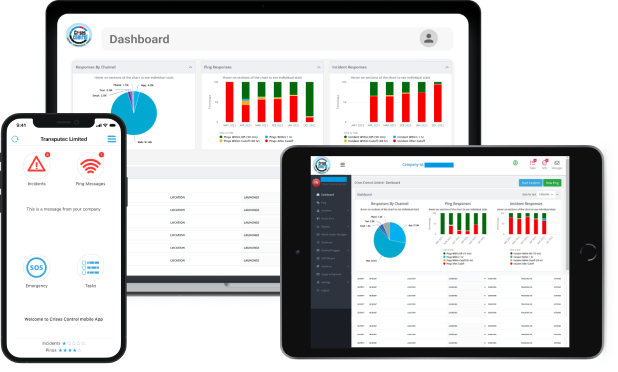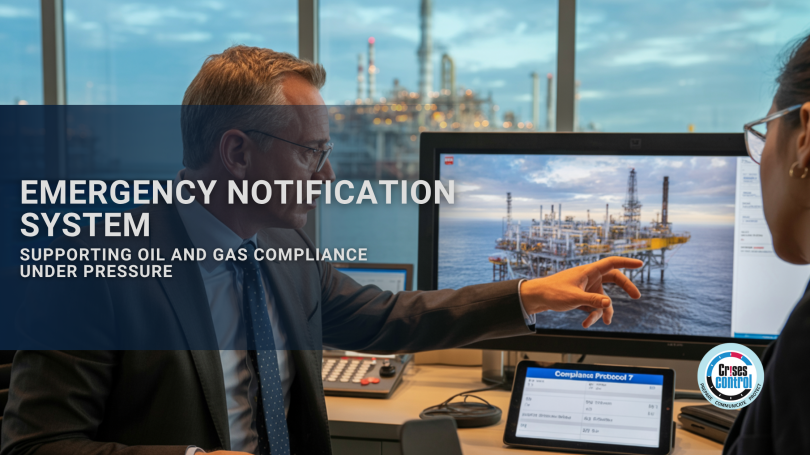Written by Anneri Fourie | Crises Control Executive
Regulatory compliance in the oil and gas industry is not optional. It’s a non-negotiable responsibility that protects people, the environment, and the long-term sustainability of operations. But meeting these obligations isn’t always straightforward. From safety regulations and environmental controls to reporting standards that vary across borders, companies face constant pressure to remain compliant in complex, high-risk environments.
What makes this even more difficult is the nature of the oil and gas sector itself. Operations are often spread across remote locations, involve hazardous materials, and require coordination between multiple teams. In such conditions, it only takes one missed alert, one delayed decision, or one undocumented incident to create a compliance issue.
So how do oil and gas organisations stay on top of this? One key part of the solution is using a reliable Emergency Notification System. But this type of system does much more than send alerts. It can play a critical role in strengthening compliance, improving incident response, and supporting a coordinated approach to operational risk.
This blog takes a closer look at how emergency communications technology supports compliance in oil and gas. It also explains how Crises Control helps organisations improve their ability to meet regulatory demands while maintaining business continuity.
Understanding the Compliance Landscape in Oil and Gas
Oil and gas companies operate within a dense web of national and international rules. Some of the most influential frameworks include:
- OSHA (Occupational Safety and Health Administration – United States)
- HSE (Health and Safety Executive – United Kingdom)
- ISO 22301 (Business Continuity Management Systems)
- EPA regulations (Environmental Protection Agency – and equivalents globally)
- SEMS (Safety and Environmental Management Systems)
- API RP 1174 (Pipeline Emergency Response)
Each regulation brings its own requirements for training, documentation, reporting, and emergency planning. But one thing they all share is the expectation that organisations can respond quickly to incidents and demonstrate exactly how they did so.
This is where many companies fall short. Too often, emergency response relies on a mix of emails, text messages, spreadsheets, and separate systems that don’t talk to each other. When something goes wrong, it becomes difficult to prove that the right steps were taken, or that key people were informed in time.
The Role of Emergency Notification Systems in Compliance
Emergency notification systems are sometimes thought of as tools for natural disasters or evacuation alerts. But in the oil and gas industry, their role is far more strategic. When used well, these systems help organisations meet legal responsibilities, improve coordination, and ensure critical incidents are recorded accurately.
Here’s how an Emergency Notification System helps with compliance:
1. Real-Time Communication During Incidents
Regulators now expect organisations to report major incidents quickly, both internally and to external authorities. Crises Control makes this possible by allowing you to:
- Notify teams instantly based on their role, location, or department
- Send messages across multiple channels such as SMS, voice call, email, Microsoft Teams and mobile app
- Track who has received and read each message
- Escalate alerts automatically if no response is received
This ensures the right people are aware of the situation without delay and creates a full record of how and when they were informed. For frameworks like ISO 22301 or OSHA, this kind of traceability is essential.
2. Coordinated Decision-Making from a Single Platform
Trying to manage an emergency with multiple tools leads to confusion. Crises Control provides a central platform where response teams can share updates, access critical documents, and work from a single plan.
This is especially important for distributed teams, such as those working on offshore platforms, pipeline networks, or refineries. A centralised view means better decisions and fewer compliance gaps.
3. Access to Pre-Built Emergency Plans
Regulations require that organisations not only write emergency plans but also make them accessible and actionable. With Crises Control, those plans can be stored securely, updated in real time, and launched instantly when needed.
Whether it’s a fire, oil spill, equipment failure, or cyberattack, staff can follow a step-by-step plan without delay. This helps ensure a consistent, regulated response every time.
Why an Integrated Approach Matters
One of the biggest problems oil and gas companies face is working with disjointed systems. Compliance teams use one platform, HSE teams use another, and emergency response might be handled through yet another set of tools.
This creates overlap, duplication, and gaps in coverage. Worse, it makes it harder to respond to regulators with clear, consistent evidence of what took place and when.
Crises Control solves this by integrating key capabilities across:
Incident Management Software for Oil and Gas
Crises Control offers tools that support:
- Recording root causes and incident timelines
- Assigning tasks and monitoring response progress
- Tracking status updates
- Generating post-incident reports
All of this reduces the admin load on compliance and HSE teams and creates a reliable, auditable record of events.
Business Continuity Management Software
Many compliance frameworks, including ISO 22301, require formal business continuity planning. Crises Control helps you prepare for disruptions and carry out regular exercises by:
- Running simulations and drills
- Evaluating team responses
- Activating recovery plans quickly when needed
The result is a higher level of readiness and a lower risk of penalties due to untested or incomplete plans.
Oil and Gas Compliance Software Support
While Crises Control is not a dedicated compliance management system, it complements them by delivering the communication and incident tracking capabilities that those platforms lack.
This includes time-stamped messaging, automated reporting, and secure documentation, all of which support the wider compliance process.
Meeting Global Standards in a Decentralised Industry
Oil and gas operations often cross borders, with teams in multiple countries working under different legal requirements. This makes compliance more challenging.
Crises Control helps by offering a platform that is:
- Scalable, so it can be used by small teams or global enterprises
- Mobile-first, so it works in remote areas and offshore environments
- Multilingual, so teams across regions can respond in their native language
- Secure, with ISO 27001-level protection and GDPR compliance
These features ensure that no matter where your teams are based, you can maintain a consistent and compliant response process.
A Better Way to Manage Compliance in Oil and Gas
For many organisations, compliance remains a reactive task. Action is only taken when something goes wrong, and systems are built around manual processes and audits.
Crises Control helps companies take a more proactive approach. Here’s how some organisations are changing their compliance strategy with help from the platform:
- Creating incident response plans that link directly to real-world triggers
- Reducing time spent preparing audit reports through automated logging
- Running scenario-based training to test team readiness
- Learning from each incident to improve plans and processes
This leads to stronger resilience, faster recovery, and fewer surprises during inspections.
Conclusion: Turning Compliance into Confidence
The oil and gas sector doesn’t have the luxury of ignoring compliance. It touches every part of the operation, from safety and environment to continuity and reputation. But it doesn’t have to be a constant burden.
With the right tools, organisations can build compliance into their day-to-day operations, making it easier to meet regulations, respond to incidents, and protect people and assets.
Crises Control provides more than just an Emergency Notification System. It brings together communication, coordination, and control into one secure platform designed for high-risk, high-stakes industries.
If you’re ready to improve how your organisation manages emergencies and regulatory demands, contact us today to book your free demo.
Request a FREE Demo

